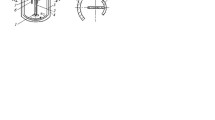A strip-intermittent combined stirrer is developed for mixing viscous fluids in order to intensify heat and mass transfer. The stirrer’s optimum structural features (number of turns and strip width) are determined from experimental results and a dependence is plotted for power factor on modified Reynolds criterion K N = f(Re M ).
Similar content being viewed by others
Avoid common mistakes on your manuscript.
In order to prepare emulsions, suspensions, and mixtures of solid substances and to intensify heat and mass transfer in chemical and petrochemical industry enterprises there is extensive use of mixing. Mechanical mixing is accomplished by mixing devices, i.e., stirrers. Stirrer construction is selected in relation to fluid viscosity, parameters of performing a production process, equipment construction, form of heating, etc. [1–3].
Mechanical stirrers with a rotary effect are mainly used in industry. During their operation, complex three-dimensional liquid fl ow arises, i.e., tangential, radial, and axial, with the predominance of a circumferential rate component [4].
We have considered industrial reactors with induction heating for mixing viscous liquids in the paint industry. Mixing intensity depends on the presence within the working volume of equipment of deflecting baffles, internal heat exchange units, pipelines, and monitoring and measuring instruments [5].
Stirrer construction specifications: it is necessary to create rapid liquid circulation for a coil pipe (in order to remove heat from equipment walls and its induction heating); high movement rates are required for the mixed medium in the lower part of equipment (in order to raise a solid phase from the equipment bottom).
To avoid stagnant zone formation between the body and coil, and also in order to provide reaction mix movement (along a spindle, i.e., downwards, but in the space between the coil and the equipment wall upwards), it is expedient to use a strip stirrer, which makes it possible to provide a sufficient viscous shear rate for displaced viscous liquid.
A construction has been developed for a strip-intermittent combined stirrer, for which in all turns (from top to bottom) in opposite quadrants there are pieces of strip. In the lower part of the stirrer, there are two horizontal oppositely directed blades, to which from below (at an angle to the movement direction) deflecting plates are welded (Fig. 1).
In performing the experiments, the efficiency of movement by strip mixers with the same diameter, but different number of turns and strip width was evaluated.
Experimental studies were performed in a model reactor with a volume of 50 dm3, geometrically similar to an industrial reactor. Ten thousand polymer granules were placed in the equipment, whose relative density was 1.05, i.e., in the immobile condition granules sank down. After a certain time interval in the upper zone a sample was collected and the number of granules within a sample was calculated. The time for which in a sample there appeared to be not less than 95% of the average specified number of granules, was taken as mixing time τ. In addition, during experiments rotation frequency n and power required N were measured. The mixing criterion nτ and power criterion K N = N/(ρn 3 d 5 m ), where d m is mixer diameter, ρ is granule density (Table 1), were calculated from the experimental data.
Dependences were plotted from experimental study results for relative values of mixing criteria and power on the number of strip turns and width (Fig. 2).
Analysis of research results showed that with an increase in strip number of turns and width the mixing time decreases, but power required increases. It has been established that the optimum construction of a strip-intermittent stirrer corresponds to five strip turns and width S = 1/6 d m.
A modified Reynolds criterion Rem = ρnd 2m /μ was also calculated from experimental data. The mixing liquid used was water and aqueous glycerol solutions, with dynamic viscosity coefficient 1–1.7 MPa·sec (Table 2).
A dependence K N = f(ReM) was obtained from test results on a logarithmic coordinate system (Fig. 3).
Dependence of power factor on modified Reynolds criterion for strip-intermittent combined stirrer (for notation, see Table 2).
Thus, the construction of a strip-intermittent combined stirrer has been developed, and optimum structural parameters have been determined: number of strip turns and width. The dependence K N = f(Rem) has been obtained for the proposed stirrer, making it possible to calculate industrial mixer capacity.
References
Yu. I. Dytnerskii, Processes and Equipment for Chemical Technology: Textbook, Part 1, Theoretical Bases of Chemical Technology. Hydromechanical and Thermal Processes and Equipment, Khimiya, Moscow (1995), 2nd ed.
A. G. Kasatkin, Basic Processes and Chemical Technology Equipment, Alians, Moscow (2009), 15th ed.
GOST 22577−77, Mixing Devices for Liquid and Inhomogeneous Fluids Terms and Determination (1978).
L. N. Braginskii, V. I. Begachev, and V. I. Barabash, Mixing in Liquid Media, Moscow (1984).
I. A. Gorlovskii and N. A. Kozulin, Paint Industry Plant Equipment: Textbook, Khimiya, Leningrad (1980), 3rd ed.
Author information
Authors and Affiliations
Corresponding author
Additional information
Translated from Khimicheskoe i Neftegazovoe Mashinostroenie, No. 5, pp. 13–14, May, 2015.
Rights and permissions
About this article
Cite this article
Leont’ev, V.K., Korableva, O.N. Development of a Combined Stirrer for Mixing Viscous Fluids. Chem Petrol Eng 51, 308–310 (2015). https://doi.org/10.1007/s10556-015-0043-y
Published:
Issue Date:
DOI: https://doi.org/10.1007/s10556-015-0043-y







